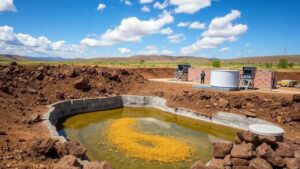Developing a Small Dredging System for Recovering Ore in Streams
Developing a Small Dredging System for Recovering Ore in Streams
The process of recovering ore from streams through dredging presents an opportunity for resource extraction while minimizing environmental disruption. This article explores the fundamental considerations and methodologies for constructing a small dredging system designed specifically for stream environments.
The Importance of Dredging in Ore Recovery
Dredging is an effective technique for mineral extraction in aquatic environments. Small-scale dredging systems can rejuvenate rivers and streams by improving navigation and preventing sediment buildup while simultaneously recovering valuable minerals. For example, the gold rushes of the 19th century demonstrated the economic potential of stream dredging, with miners using simple tools to extract gold particles from sediment.
Designing the Dredging System
When designing a small dredging system, several components and technologies need to be integrated into a coherent system. Key elements include:
- Dredge Type: Consideration of the desired dredge type is crucial. Options include suction dredges, where material is vacuumed from the riverbed, or mechanical dredges, which use a scoop to extract materials.
- Power Source: Dredging systems often employ portable gas or electric pumps for suction dredging. A reliable power source ensures efficient operation over extended periods.
- Material Separation: Including a classifier or sluice box after the dredging process enables effective separation of valuable ores from sediment. This process often utilizes water flow to facilitate the separation.
Environmental Considerations
Environmental stewardship should guide the development of dredging systems. It is essential to assess the ecological impact of dredging on stream habitats. Factors to consider include:
- Water Quality: Regular monitoring of turbidity and contamination levels during the dredging process helps protect aquatic ecosystems.
- Habitat Disruption: Useing practices that minimize the disturbance of stream beds and surrounding vegetation is vital.
Case Study: Successful Small Dredging Operations
A notable example of an efficient small dredging system is found in the operation of the “Gold Cube,” which utilizes a multi-stage separation process for gold recovery. This system is designed for portability and can operate in various stream conditions. According to data from user reports, this system increases recovery rates up to 97% in targeted areas.
Real-world Applications
Small dredging systems are not limited to gold recovery. can also be effectively utilized in the extraction of precious metals like platinum and in the mining of sand and gravel for construction purposes. For example, an operation in Oregon successfully recovered valuable aggregate by employing a small dredging system which utilized a combination of suction and separation technologies.
Regulatory Considerations
Before commencing dredging activities, it is essential to obtain the necessary permits and comply with local regulations. This often includes:
- Environmental Impact Assessments: Conduct assessments to identify potential impacts on local wildlife and ecosystems.
- Water Rights: Ensure compliance with local water rights laws to avoid legal complications.
Conclusion and Actionable Takeaways
The development of a small dredging system for recovering ore in streams requires careful planning and execution, ensuring that both economic and ecological factors are considered. By addressing design, environmental concerns, and regulatory frameworks, operators can successfully implement effective dredging strategies.
In summary, to begin developing a small dredging system:
- Evaluate the mineral types available in your target area.
- Assess the environmental impact and secure necessary permits.
- Design a system that combines efficient dredging and effective material separation.
With the right approach, small-scale dredging can offer a sustainable avenue for ore recovery while promoting environmental responsibility.

